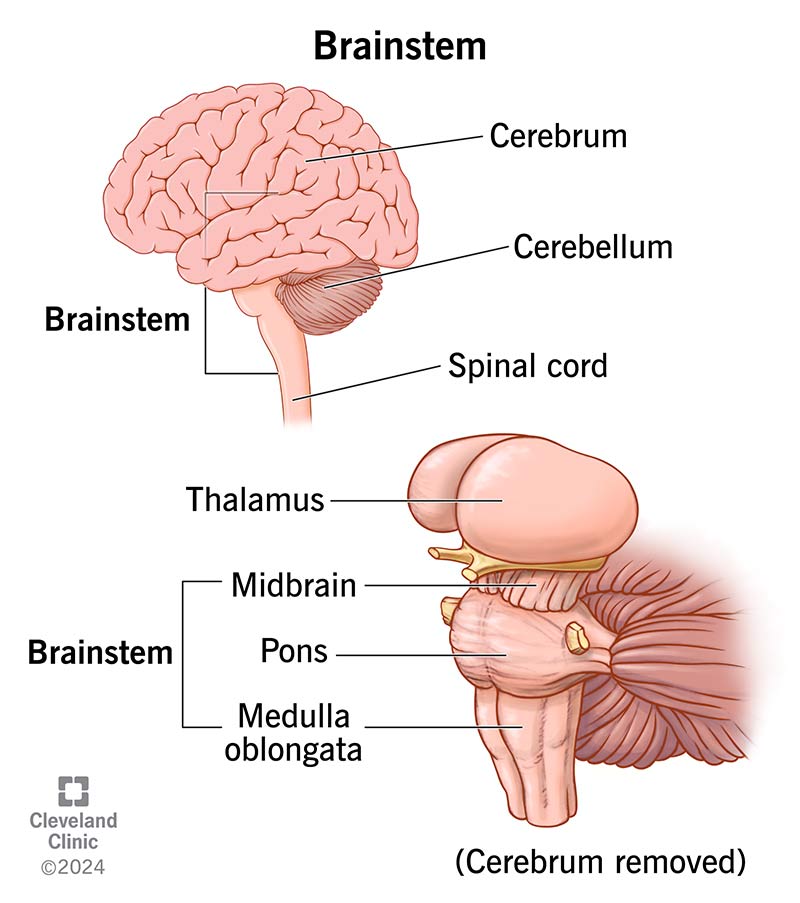Your brainstem connects your brain to your spinal cord. It sits at the bottom of your brain and includes the midbrain, pons and medulla oblongata. Your brainstem sends messages to the rest of your body to regulate balance, breathing, heart rate and more.
Advertisement
Cleveland Clinic is a non-profit academic medical center. Advertising on our site helps support our mission. We do not endorse non-Cleveland Clinic products or services. Policy

Your brainstem connects your brain to your spinal cord. It sits near the bottom of your brain. It helps regulate vital body functions that you don’t have to think about, like breathing and your heart rate. Your brainstem also helps with your balance, coordination and reflexes.
Advertisement
Cleveland Clinic is a non-profit academic medical center. Advertising on our site helps support our mission. We do not endorse non-Cleveland Clinic products or services. Policy
It’s part of your central nervous system and has three parts that work together. Each part does a specific job to help you adapt to your environment, move and function.
Your brainstem sends messages back and forth between your brain and other parts of your body. It regulates many involuntary actions — functions your body performs automatically, like:
Brainstem reflexes are your body’s immediate and involuntary motor responses that help you survive and adapt to changes in your environment. You aren’t consciously thinking about performing these actions. Instead, your brainstem automatically tells your body to do them.
Brainstem reflexes include:
Advertisement
Your brainstem is located near the bottom of your brain, at the back of your skull. It connects your brain to your spinal cord.
Your brainstem is made up of three parts:
Your brainstem also contains your reticular activating system (RAS). The RAS is a network of neurons (nerve cells that carry electrical signals and chemicals through your brain). It works with your thalamus to manage your:
Your brainstem contains 10 of the 12 cranial nerves (nerves that start in your brain) including cranial nerves 3 through 12. They help with your movements, sensations, taste and hearing.
Your brainstem looks like a flower stalk or a stem of a plant. It’s a tube-like structure made of neural (or nervous system) tissue. It’s about 2 to 3 inches (5 to 7 centimeters) long.
A wide range of injuries and health conditions can damage your brainstem. Some of these include:
Because so many issues can affect your brainstem, signs and symptoms can vary significantly. In general, signs or symptoms of a brainstem injury or condition can include:
If you experience an injury that damages your brainstem, you might have the following symptoms:
Brainstem damage is an emergency. Many people experience brainstem damage after a severe car accident, for example. Damage can affect how well your brainstem can work. In severe cases, your heart may stop beating, you won’t be able to move (paralysis) and you may be in a coma.
Advertisement
Many brainstem conditions are life-threatening or fatal. You may need life support. It’s important to call emergency services right away if you experience any symptoms related to brainstem damage.
Brainstem death means your brainstem stops functioning. It occurs when something permanently damages the brainstem or cuts off your brain’s blood or oxygen supply.
Because your brainstem controls essential life functions, you won’t be able to regain consciousness. You’ll need artificial life support to remain alive. This condition is also called brain death.
A brainstem injury can have severe effects because your brainstem controls so many of your body’s most important functions. But people do recover from some types of brainstem injuries.
It’s important to get care right away if you think you might have a brainstem injury. The sooner you get care, the more likely your healthcare providers can reduce the severity of the damage. You may need rehabilitation and other special care after a brainstem injury.
Imaging tests, like an MRI, are more sensitive than a CT scan in detecting problems with the brainstem. Brainstem Auditory Evoked Potentials (BAEPs) can also provide information on brainstem function.
Advertisement
As your brainstem is responsible for many vital functions and reflexes, during an exam, your provider may also:
Located at the bottom of your brain, your brainstem plays an important role in many things you don’t even think about, like breathing and maintaining your heart rate. Injury to your brainstem can have a significant impact. Fortunately, recovery from brainstem injury is possible, so getting medical attention quickly is key. Recovery from this sort of injury can be a long road. Be patient with yourself and lean on your family and healthcare providers who are there to support you.
Advertisement
If you have a neurological condition, you want expert advice. At Cleveland Clinic, we’ll work to create a treatment plan that’s right for you.

Last reviewed on 06/12/2024.
Learn more about the Health Library and our editorial process.